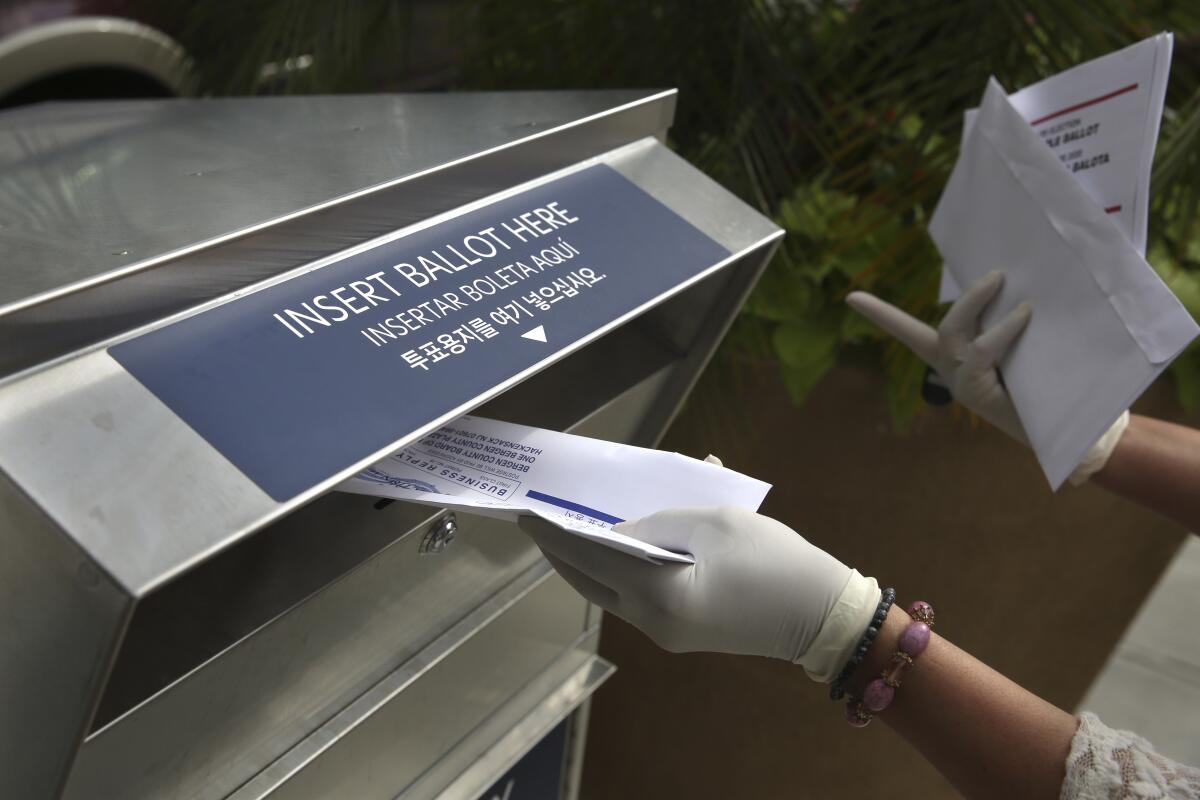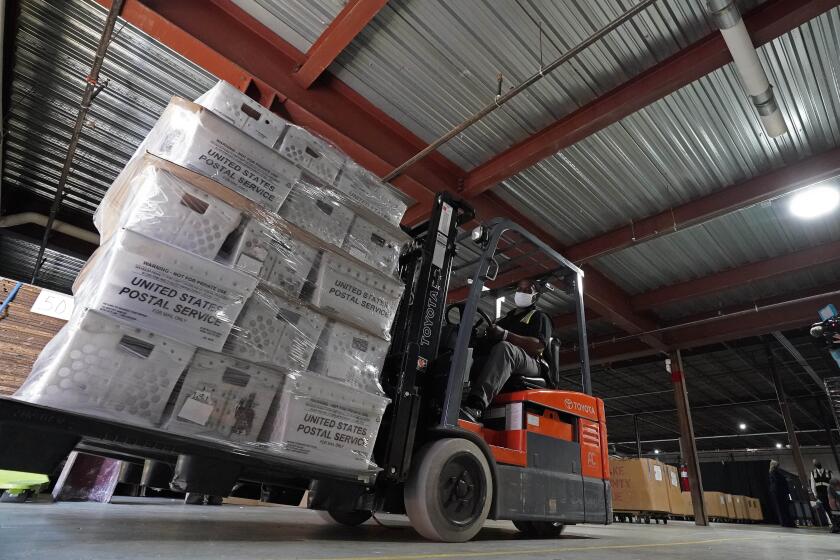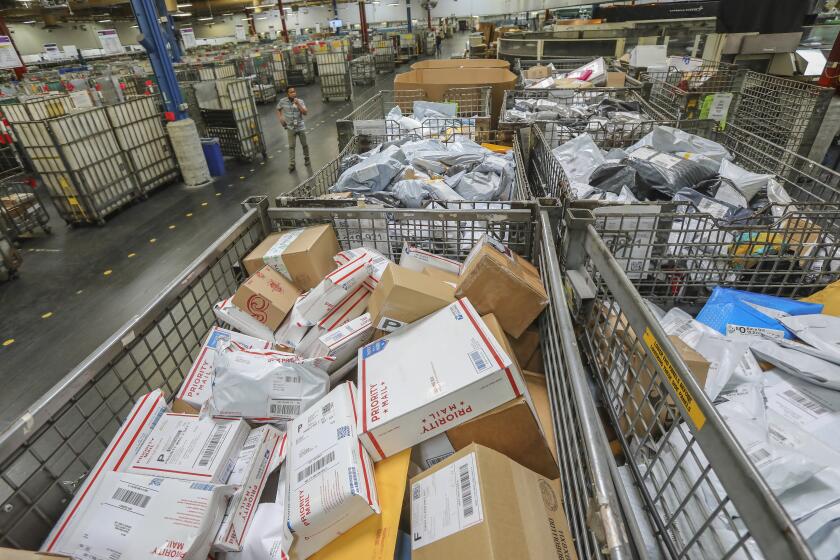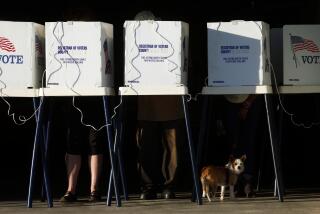A million mail-in ballots could go uncounted this fall. The USPS may not be to blame

- Share via
WASHINGTON — The controversial new chief of the U.S. Postal Service had not even started his job when a disturbing thing happened to hundreds of thousands of Americans who cast ballots by mail in primary elections this spring.
Their votes were never counted.
The torrent of disenfranchisement provided a worrying prelude to a general election in which, for the first time in history, most Americans will probably vote in advance of election day. Amid President Trump’s efforts to undermine mail voting and the tumultuous tenure of Louis DeJoy, the Trump loyalist now running the mail, many people see the Postal Service as an obvious culprit.
But election experts say recent controversies surrounding the post office and Trump’s campaign of disinformation about mail-in voting are mostly sideshows. The bigger dangers for voters predate this administration and involve election officials in the states.
When ballots get tossed, one of the most common reasons is that states mislead voters into thinking they can safely wait until a day or two before election day to drop them in the mail. Even when the post office is running on all cylinders, that isn’t enough time to guarantee votes will be counted in many states.
“It is unrealistic and wishful thinking by these states,” said Charles Stewart III, a political science professor at MIT who focuses on voting.
“They set the deadline as close as they can to election day, taking the position [that] we are giving people as much opportunity as possible to vote by mail. It has done the opposite. It has set up voters to fail.”
Missing the deadline for ballots to be delivered to election officials was the main reason that about 1% of all mail ballots were tossed in 2016. Amid this year’s rapid shift toward mail voting, the percentage has surged higher in some states. More than 5% of mail votes were thrown out during this year’s primary in Virginia, for example, according to figures reported by National Public Radio.
In Wisconsin, about 2% of ballots — around 23,000 votes — were rejected in the primary. That was a larger share of votes than Trump’s winning margin in the last presidential election.
Nationwide, the number of mail-in voters disenfranchised this year already has exceeded the total for the entire previous presidential election cycle by more than 200,000. With polling suggesting that roughly one-third of voters — perhaps as many as 50 million people — plan to vote by mail, the uptick in discarded ballots is worrisome in an already chaotic election.
Even if all voters sent ballots by mail in this year’s general election, delivering them would be no problem for a Postal Service that handles 3 billion cards and letters a week during a typical holiday season, said Mark Dimondstein, president of the American Postal Workers Union. The key is that voters have to allow enough time for their ballots to arrive, and states need to provide accurate information about the deadlines.
That clearly did not happen during the primaries.
Between early June and mid-August, more than 1 million ballots were mailed out to voters so late — within a week of primary election day in their state — that they put voters at “high risk” of having their completed ballots arrive too late at election offices to be counted, according to a new report from the Postal Service inspector general.
In 34 states, officials ignore Postal Service guidance to set a deadline for distributing absentee ballots to voters more than seven days before the election.
Deadlines vary from state to state. California has among the most voter-friendly rules, allowing ballots to be counted for days after an election as long as they are postmarked by election day.
These states will probably decide if Joe Biden or President Trump wins the election. And their absentee ballot laws could determine when we find out.
Most states, however, require ballots to arrive by election day, according to a compilation by the National Conference of State Legislatures. States also vary in how easily voters can resolve problems with mail-in ballots, such as a signature that doesn’t precisely match the one on file — another leading cause of ballots being disqualified.
About 30 states have websites that allow voters to track whether their ballot has been received and whether it has been accepted for counting. In August, California Secretary of State Alex Padilla announced the launch of a ballot-tracking tool for state voters.
Elections experts worry that voters aren’t hearing enough about those deadlines and sources of information. They are instead getting dire warnings from lawmakers about post office management issues that have caused serious problems with delivery of medicines, perishable items and even live animals, but which even major postal unions say are not going to disrupt their ability to deliver ballots, especially now that DeJoy — facing a public outcry — has vowed to put some of his plans on hold until after the election.
Accounts from employees at California postal facilities provide a glimpse of the chaos amid both the pandemic and widespread cuts imposed by the USPS.
“I understand the Democrats’ inclination to sound the five-alarm fire here, but you want to make sure that people are confident in their mail ballots,” said Nathaniel Persily, a Stanford professor who co-directs the Stanford-MIT Healthy Elections Project with Stewart.
The message that should be directed at voters, Persily said, is that mail voting will work fine if ballots are mailed back at least a week before election day.
“One of the things I hope the Postal Service [controversy] has done is convince everyone that if they want to vote by mail, they should do it as early as possible,” he said.
That message is especially important in states that don’t have much experience with widespread mail-in voting. In New York City, for example, more than 1 in 5 ballots were rejected in June’s primary. Until this year, voting by mail had accounted for just a small share of ballots cast in the state, and election officials were overwhelmed by a tenfold increase.
In California, more than 100,000 ballots went uncounted during this year’s primary, about 1.5% of the nearly 7 million cast. More than two-thirds of those were discarded because they arrived too late. Most of the rest had missing or defective signatures.
For November, the state has extended the deadline for receipt of ballots by two weeks, as long as they are postmarked by election day.
In other states, proposals to extend ballot deadlines or take other steps to avoid disenfranchising voters have stalled amid a coordinated push by the Trump campaign and the Republican National Committee against expanded use of mail-in ballots.
Further complicating matters is the president’s persistent spread of disinformation about mail voting, falsely claiming it is highly vulnerable to fraud and is a conspiracy against him. The installation of DeJoy in June fueled fears by Democrats that the administration was seeking to rig the system against absentee voters. Polls have repeatedly shown that more Democrats than Republicans say they plan to vote by mail this year.
Though DeJoy has backed down to a large extent on his aggressive cost-cutting measures, the confusion he helped create has rattled voters. A new Wisconsin poll by Marquette Law School, for example, shows the number of voters in that key swing state who say they plan to vote by mail has dropped considerably since May, from 43% to 32%.
“He played a role, wittingly or unwittingly, in undermining people’s confidence in voting by mail, which fed into the suppression tactic of ‘there is something wrong with voting this way,’” Dimondstein said.
Some groups are scrambling now to get word out about the importance of mailing ballots early. They are testing new mobile apps, distributing ballot-tracking tools and deluging social media in an effort to push voters to request and return their ballots early.
On the Republican side, state parties that have long relied on mail-in voting, especially by older people, are scrambling to find ways to encourage their side to vote despite the president’s attacks on mail balloting.
On the left, organizers are emphasizing that ballots not returned by the week before the election should be brought to drop boxes set up at polling places, election offices and elsewhere.
“We are encouraging every single voter to know the rules and make a plan,” said Wendy Fields, executive director of the Democracy Initiative, a coalition of progressive groups working to expand voting rights.
“This is a high-information moment. We are making sure folks are checking their registration, getting the ballot, getting it done and getting it in the mail,” Fields said. “We need to keep our foot on the gas.”
Fields said activists are also guiding voters to alternatives to mail if they can’t get their ballot to the Postal Service in time.
Educating voters is a steep challenge this cycle. The COVID-19 pandemic and legal fights over how voting should be carried out are causing frequent changes in state rules. Misinformation abounds.
And progressive groups continue to highlight the fights over the post office in fundraising campaigns, which often suggest that mail voting could be imperiled, further confusing voters.
“Providing clear and accurate information to voters in a timely manner is the biggest challenge we face,” said Tom Lopach, chief executive of the Voter Participation Center, a nonprofit that has registered more than 1 million voters for the 2020 election.
Times staff writer Noah Bierman contributed to this report.
Get our L.A. Times Politics newsletter
The latest news, analysis and insights from our politics team.
You may occasionally receive promotional content from the Los Angeles Times.
More to Read
Get the L.A. Times Politics newsletter
Deeply reported insights into legislation, politics and policy from Sacramento, Washington and beyond. In your inbox three times per week.
You may occasionally receive promotional content from the Los Angeles Times.













